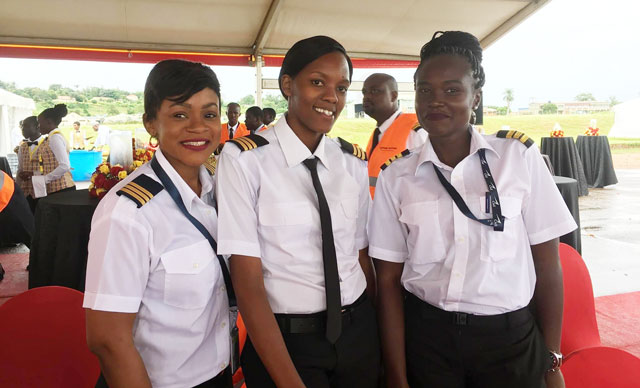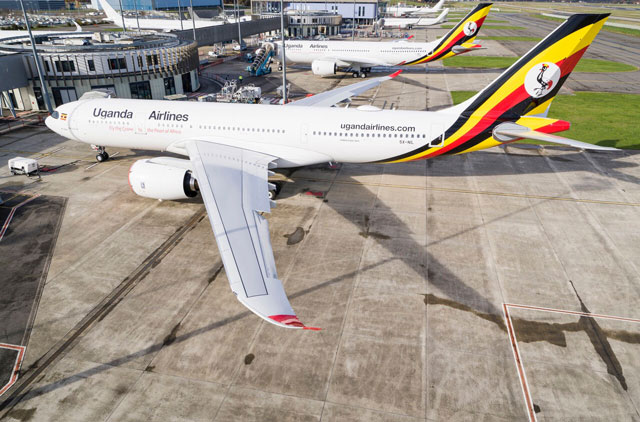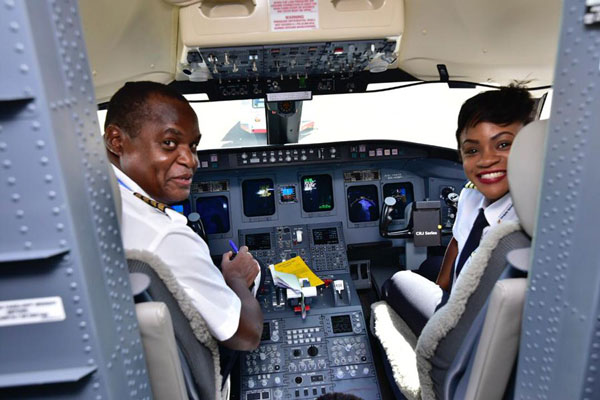
Vernita Kayiwa and Tina Drazu will be the first Ugandan women to fly the wide body Airbus A330. They have gone further in their civilian flying careers than any Ugandan women ever, no mean feat and worth celebrating
COMMENT | DEREK NSEKO | Now that the dust has settled on Uganda airlines’ fleet expansion, it is time to reflect on what this means not just for the airline but for ordinary Ugandans who no doubt should look at those four CRJ aircraft and two Airbus A330s as something to be proud of.
It is important to note that, the shinny new planes are not a trophy or a subject for bragging rights at the East African table. This is serious business and the Ugandan people have forked out hundreds of millions of dollars perhaps even at the cost of more pressing national priorities.
But what exactly should we be proud of and what does this really mean for Ugandans at large?
In 2014, unfortunate events at the UCAA led to the loss of the biggest platform that Uganda’s aviation professionals had in the country at the time. So many jobs were lost as a result of the collapse of Air Uganda, a company that was privately owned at the time. The future was bleak for both the consequently unemployed and the potential aviators who were looking at the national airline as their end game.
Fast forward 2021 and the outlook is completely different. The new Uganda airlines currently employs 50 pilots with about 42 being Ugandan. Among this elite group are five Ugandan women.
Two of these ladies, Vernita Kayiwa and Tina Drazu are flying the Airbus A330. They have gone further in their civilian flying careers than any Ugandan women ever, the very first to fly wide body aircraft, no mean feat and worth celebrating.
Only about 5% of airline transport pilots in the world are female. That women represent 10% of the pilots at Uganda airlines is a relatively positive sign and long may it continue as the crew grows in number.
There is no doubt that a gender barrier exists in aviation, an industry that has always been viewed with a macho stereotype. And of the many industries around the world that are male dominated, it continues to be one of the least transformed.
Only about 5% of airline transport pilots in the world are female. That women represent 10% of the pilots at Uganda airlines is a relatively positive sign and long may it continue as the crew grows in number.
A lack of positive role models has been cited as one of the reasons why the number of female pilots continues to lag. Women simply cannot envision themselves in a cockpit. The revival of Uganda airlines heralds a new dawn of opportunity for the next generation of Uganda’s aviation professionals across all demographics.

Chief Pilot Michael Etiang believes a diverse crew is great for building larger mindset in the company as it facilitates greater flow of broad experiences and insights.
“As we seek to build a National Airline with international reach and given the large number of Ugandans in the diaspora many of who are in intermarriages it’s good for us to be broad minded in our approach to people , different cultures and knowledge. As for females I have always encouraged women pilots and take pride in their success after all I am a father of two girls plus one boy,” Etiang said
Uganda Airlines HR, he reveals, encourages gender balancing and in Flight Operations as they try to ensure women are represented fairly
National airlines are key
National airlines are designed to contribute to a country both economically and socially. While the latter might be a compromise that sometimes effects the bottom line, it is critical on a continent whose ground transport infrastructure is still lacking.
National airlines have been known to fly routes that are not economically viable but are important for social connectivity and with a trickle-down effect in mind. This however does not justify an inefficient and loss-making operation, it however highlights that the national airline can be viewed through the broader effects on society and economy, especially the resulting growth in GDP
If aviation were a country, it would rank 20th in the world based on GDP, a rank only comparable to some of the world’s most developed economies.
The sector plays a valuable role in the efficient transportation goods and very high volume of cargo is transported within and out of Africa.

African Continental Free Trade Area comes on time
With the African Continental Free Trade Area (AfCFTA) finally coming alive, this is set to multiply and air transport will be at the forefront of the logistics value-chain.
Africa with its rich and fertile soils has the potential to be a major player in global agriculture and entrepreneurship, however much depends on the efficiency of the supply chain.
The global pandemic has highlighted the importance of a cargo division to airline operations. Indeed many airlines including Ethiopian and Kenya airways have had to pivot and convert passenger aircraft to freighters. Uganda airlines will be no different in recognizing the importance of its own cargo operation. Ugandan farmers and traders will reap the benefits.
From Entebbe to the world #DUBAI #MUMBAI #LONDON #GUANGZHOU…. Coming soon #ANewWorld of greater connectivity
pic.twitter.com/XNkcViYIMM
— Uganda Airlines (@UG_Airlines) January 25, 2021
Uganda airlines’ long haul route network will connect Dubai, Mumbai, London and Guangzhou and it is no coincidence that these destinations represent Uganda’s largest import and export markets. China is a particularly popular source for electronics and manufactured goods with India playing a big role in providing Pharmaceuticals.
The main exports out of Uganda will be boosted tremendously by a more efficient point to point air transport service out of Entebbe.
Fruits and vegetables form 46% of the export market, fish takes up 45% and flowers occupy 3%. All these goods are dependent on the logistical efficiency of air cargo and it is these sectors that will be boosted and perhaps even find significantly greater investment as a result of the air connectivity provided by the national airline.
There is no doubt that the revival of the airline will inspire a bump in the country’s gross domestic product.
Key questions however persist. Will the Crane soar across the region and beyond?What does this mean for domestic air connectivity? Does air transport form part of the picture of Uganda’s domestic transport infrastructure?

A domestic air transport network requires an existing ground infrastructure to support it.
According to a UCAA master plan, airports at Arua, Kasese, Pakuba and Kabaale will be further developed with Kabaale becoming an international airport.
But less than 20,000 passengers flew domestically in Uganda for the year leading up to 2020, this largely through charter operations.
The Minister of @MoWT_Uganda Hon @GenWamala, Minister of State (Works), Hon. Peter Lokeris and the Minister of State (Transport), Hon Joy Kabatsi have inspected the ongoing works for Kabaale (Hoima) International Airport.Progress of works stands at 42.91% so far. @UgandaMediaCent pic.twitter.com/Y8ftOGpfyv
— Uganda CAA (@UgandaCAA) June 25, 2020
The market is simply too small and extremely expensive, dominated and tailored to tourists who can match price with their competitive currencies.
The plan for the national airline is to create domestic franchise partnerships with the existing players, a move that if put into effect could boost the domestic air transport sector. That could also help drive prices down with the effect that air transport will become more affordable and accessible within the country.
The airline’s revival and particularly the arrival of brand new Airbus aircraft has sparked collective national cheer. Only the sports version of the Cranes has transcended political and sectarian divisions in such a manner. Long may this continue, because the national airline will need the support of the entire country.
********
 The writer, Derek Nseko is an aviation expert, a qualified commercial pilot and managing director at iFly Global derek@nseko.com twitter: @av8r_derek
The writer, Derek Nseko is an aviation expert, a qualified commercial pilot and managing director at iFly Global derek@nseko.com twitter: @av8r_derek
 The Independent Uganda: You get the Truth we Pay the Price
The Independent Uganda: You get the Truth we Pay the Price






